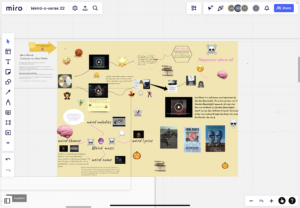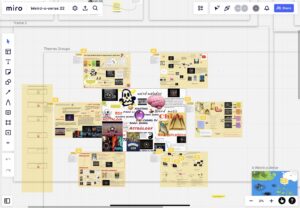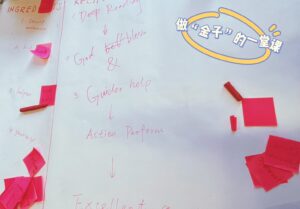Week1&2:Weird Studies
“Weird Studies”: an academic field that does not and cannot exist.
First,let’s do an interview with the question, what do you think is weird?
Student A: As far as I’m concerned,Weird means that someone or something is different from most people and things. It’s often a derogatory term.weird people often endure the loniness and pain that ordinary people can not understand.But I think weird sometimes means to be unconventional, not compromising with the vulgar,Van Gogh is a typical example.Who would have thought that a strange people like him his work can be immortal.
30542D4A-4086-495D-B023-9D5E9F2FDDB1
StudentB: Wired for me is something that makes me uncomfortable. And I don’t know and don’t understand one thing that comes to mind is Tiktok. I don’t understand the trend on Tiktok and why people find it interesting.
3AC793D3-92A0-419F-A65C-71DC58CA2C21_2_0_a
It seems we can all get a general understanding of weirdness. To put it in academic terms:Weird is something that resists any given explanation or frame of reference.Our first reaction to anything that seems to us to be at odds with the established facts is: weird.
In the case of art: how does a work of art break our habits of perception? I am speaking for myself and discussing my understanding of weird art.Here we focus on one form of artistic expression: weird music.
I.Weird Music
Music that is loosely referred to as weird can often be subdivided into weird themes, weird melodies, weird lyrics, weird song titles ……
First of all,I would like to mention a self-created conlang: monsmusic: All music that sounds weird, although it may be scary like a “monster”, it has a great energy, a power that gives people hope. I will discuss the focus of this section using the music ‘Everywhere at the end of time’ as an example.
-
Weird Themes
Everywhere at the End of Time is the eleventh recording by British electronic musician The Caretaker (real name Leyland Kirby) and consists of six pieces of music divided into stages and named to simulate the process of Alzheimer’s disease from onset to The theme is a break from our usual
Such a theme, which breaks with our usual musical perceptions, is certainly a special feature in the emotionally charged world of music. It makes us try to slow down in a fast-paced and frenetic society, to listen to the most authentic sounds of the world and to feel the passage of time.
-
Weird Structures
The album in its entirety runs for over six hours, presenting a variety of moods and characterised by uninterrupted noise. The first three stages are similar in style to ‘Beyond This World’, but in the last three stages there is a gradual departure from Kirby’s earlier atmospheric musical work. This series of albums reflects the patient’s failing memory, physical and mental disorder, and the return of light at the end of his mortal life.
Through the musical compositions, the composer subtly narrates the structure of the vital signs of Alzheimer’s patients. The undulating and elusive melodies throughout the album are emotionally charged and make a strong auditory impact in contrast to the uniformity of popular music.
-
Quirky Charm
Such music was distinct from the mainstream, but the series grew in fame and social repercussions as it was released in its various stages.
The End of Time is considered Kirby’s masterpiece, with critics lamenting the concept of dementia behind its length and putting it on the list of best albums of the 2010s. In 2020, the series became an internet phenomenon, with several videos appearing on TikTok challenging the audience to listen to the whole thing in one sitting, and users compiling it into a module for the rhythm game Friday Funk Night. .
Although this type of music is different from the public’s aesthetic perception, there is no denying that it has a strong perceptual impact on the public, both visually and aurally, and that is what makes it so appealing. This type of weird art exists not only as a work of art in itself, but also as a lifeline between the public and the meaning behind it.
II.My Practice Of Weirdness
- Through two weeks of study, I have had a preliminary study and understanding of weird research. I created a wierd space in miro to represent my own weird logical framework.

2. I had the pleasure of working with my Basho group members to sort out our individual wierd spaces and bring them together into one big weird scene.

During my studies on the subject of weirdness, I became interested in weirdness. Through my reading, I learned about Christopher Burke, an original musician who has done some research into the weird. What struck me was his commentary on a strange novel “Ghosts of the Empty Hour”: sometimes ghosts are buildings and paths that have been or will be abandoned, hints of ideas not yet infused with life but with supernatural powers of expression, strange cycles whose precedents can never be traced, deconstructing the subject matter of ourobouros rootless remnants. The devil is in the details, as an ephemeral image may appear, which makes the previous stories disturbing, expanding the world of each story through allusion and helping to re-interrogate events in a profound way. That is, a point in time that we encounter in reality may have appeared in our minds before. This oddity is confusing.I will therefore study further by reading in greater depth.

3. The classroom learning about making ‘gold’ has allowed me to think outside the box about what is most meaningful in my personal world. The group and I actively discussed and worked together, and although there were differences of opinion in the process, we eventually settled on a goal and planned to make a common ‘gold’

4. For the conspiracy theory , I worked with the group to make up a story about the connection between the amount of money Americans spend on various things and the way they commit suicide. So we found material in the news about extraterrestrials, book buying rates, etc. and made up a story about scientists who envisioned “controlling” people’s lifestyles through extraterrestrial research. The news itself was unconnected, but through our storyline a conspiracy theory was created




A few comments on what you have posted for Sprint 1:
What does the interview do? Does it show that everyone – possibly – has their own ‘weird’? What does that tell you?
When you state that you are putting the weird in “academic terms” – what terms exactly are you referring to? You need a context here – a reference to at least one scholarly source. There are basic histories and theories of the Weird in the Resource List for Sprint 1 that you could easily have read and drawn on here: e.g. Noys, B. & Murphy, T.S. (2016) Introduction: Old and New Weird. Genre (Norman, Okla.). 49 (2), 117–134. doi:10.1215/00166928-3512285. Saying that the weird is “something that resists any given explanation or frame of reference” is to quote the Weird Studies podcast – and needs a citation i.e. https://www.weirdstudies.com/about. This statement poses a paradox of sorts – which you neither note nor address. Unpacking the Problem Scenario is really important here. What sort of issues is the Problem Scenario posing? How might you tackle them?
It’s good to see you use a concrete example her re: whether or not a work of art can break our habits of perception. Kirby’s musical work serves as a case study well enough; but it’s not clear why you chose Kirby and why you didn’t look at contemporary art for an example. Equally, you don’t return to the Weird Studies podcast here (which, again needs a citation) means you don’t really manage to address the Problem Scenario.
Christopher Burke also – potentially – could work well as a case study. However, when you discuss Burke’s contributions here, you don’t remember to relate it back to the Problem Scenario. What might Burke offer here specifically?
Make Gold was a workshop for your other course (Contemporary Art & Open Learning), so shouldn’t be in this blog.
You describe what you did in the Conspiracy Theory Workshop, but you haven’t analysed or reflected upon this critically nor do you relate this back to the Problem Scenario. You need to move beyond description and pick apart what you have been learning here.
What might you do differently here?
I think the Alzheimer’s related monsmusic neologism is a good place to start. You could build upon the basic definition of monsmusic to create a theory of monsmusic that allies it with the key issues raised in the Problem Scenario. To figure out what issues are being raised – and which ones to focus on – you need to do some structured reading around the topic in question and some Critical Thinking https://www.ed.ac.uk/institute-academic-development/study-hub/learning-resources/critical
Reworking this post by critically framing it around monsmusic might lead to a better outcome.
Dear Neil ,Thanks for your comment, I will think carefully and make a number of changes.❤️